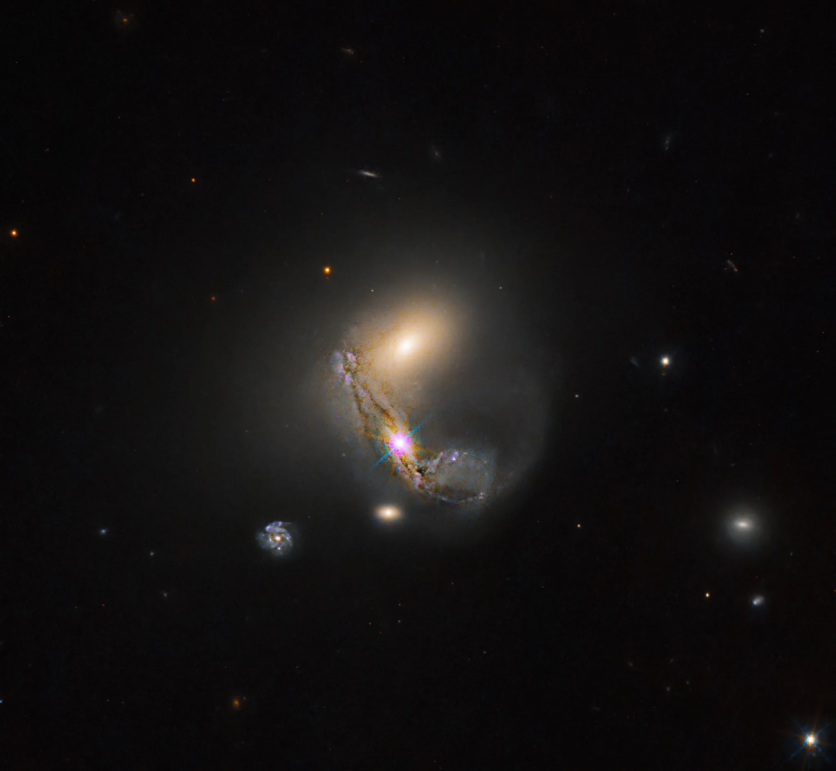NASA Hubble Space Telescope has captured a mesmerizing image of a group of interacting galaxies known as LEDA 60847.
NASA Hubble Space Telescope Captures Heart of the Cosmic Ballet
At the heart of this cosmic ballet is an active galactic nuclei (AGN), a classification denoting galaxies with a supermassive black hole at their core, voraciously accreting surrounding material.
The presence of an AGN results in the emission of radiation across the entire electromagnetic spectrum, casting a brilliant glow into the cosmic expanse.

Such luminous phenomena provide astronomers with a unique opportunity to unravel the mysteries of supermassive black hole growth and its profound impact on the galaxies they inhabit.
NASA noted that galactic mergers, like the intricate dance observed in LEDA 60847, are common in cosmic theater. Most larger galaxies, including our own Milky Way, bear the imprints of smaller galaxies fused together over cosmic epochs.
Estimates suggest that anywhere from 5% to 25% of all galaxies are engaged in the mesmerizing choreography of merging.
Read Also : NASA Hubble Discovers Saturn's Ring System Heats Planet's Atmosphere-A Never-Before-Seen Phenomenon!
A Blending of Lights in Latest Hubble Image
This latest Hubble image, a harmonious blend of ultraviolet, visible, and near-infrared data, showcases the telescope's unparalleled ability to explore the cosmos across a broad spectrum of wavelengths.
Each band of light provides astronomers with unique insights into the intricacies of our universe. Ultraviolet light, for instance, unveils the radiant glow of stellar nurseries, offering a glimpse into the birth of the hottest stars.
Visible light, resembling the view perceptible to the human eye, unveils the tapestry of moderate-temperature stars and cosmic material. Lastly, near-infrared light can remarkably penetrate cold dust, enabling the study of warm gas, dust, and relatively cool stars.
The legacy of astronomer Edwin Hubble, who revolutionized the study of galaxies based on their appearances, lives on through the Hubble Space Telescope.
Initially categorizing galaxies into three fundamental shapes - spiral, elliptical, and irregular - Hubble's pioneering work paved the way for a deeper understanding of these cosmic islands.
The telescope named in his honor subsequently assumed the role, disclosing unprecedented intricacies within galaxies, revealing elaborate dark dust lanes, and illuminating luminous clusters of star formation.
Hubble's discerning observations have not only demystified the enigmas surrounding supermassive black holes nestled at the cores of massive galaxies but have also immortalized the celestial dance of merging galaxies.
Previous images encompass snapshots of colliding galaxies resembling a "Great Pumpkin," a "Space Triangle," the "Antennae," and the ethereal "Mice." Despite their outwardly chaotic appearance, these galactic collisions transpire at a glacial pace, unfolding over hundreds of millions of years.
Related Article : NASA's Hubble Space Telescope Captures 'Butterfly Nebula' In Stunning Motion | Fun Facts About This Beautiful Space Butterfly

![Apple Watch Series 10 [GPS 42mm]](https://d.techtimes.com/en/full/453899/apple-watch-series-10-gps-42mm.jpg?w=184&h=103&f=9fb3c2ea2db928c663d1d2eadbcb3e52)



